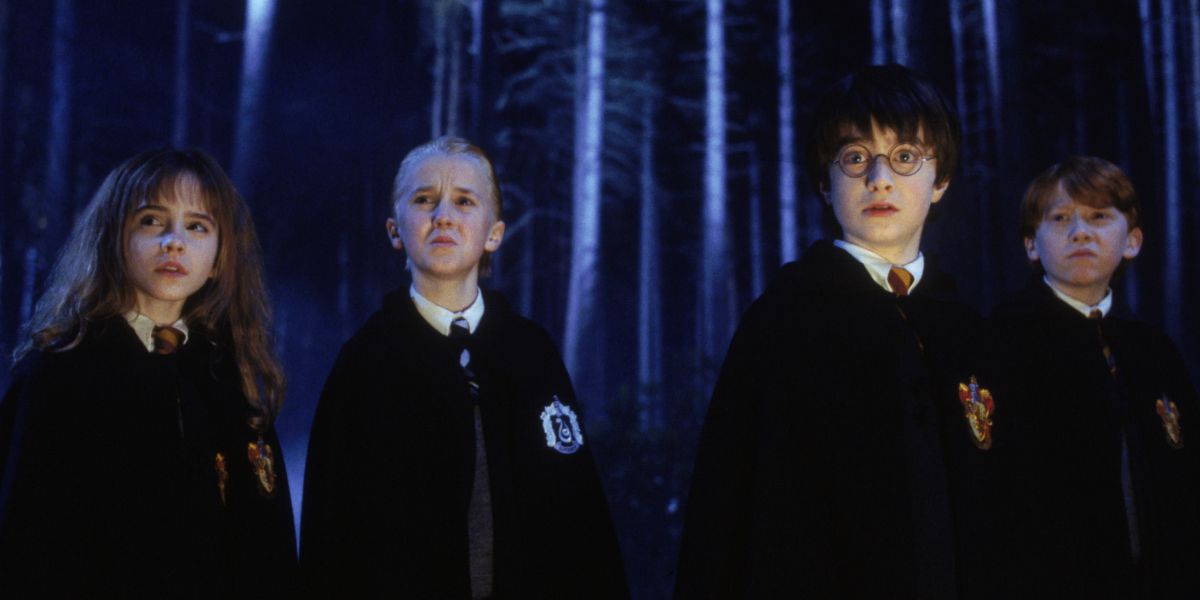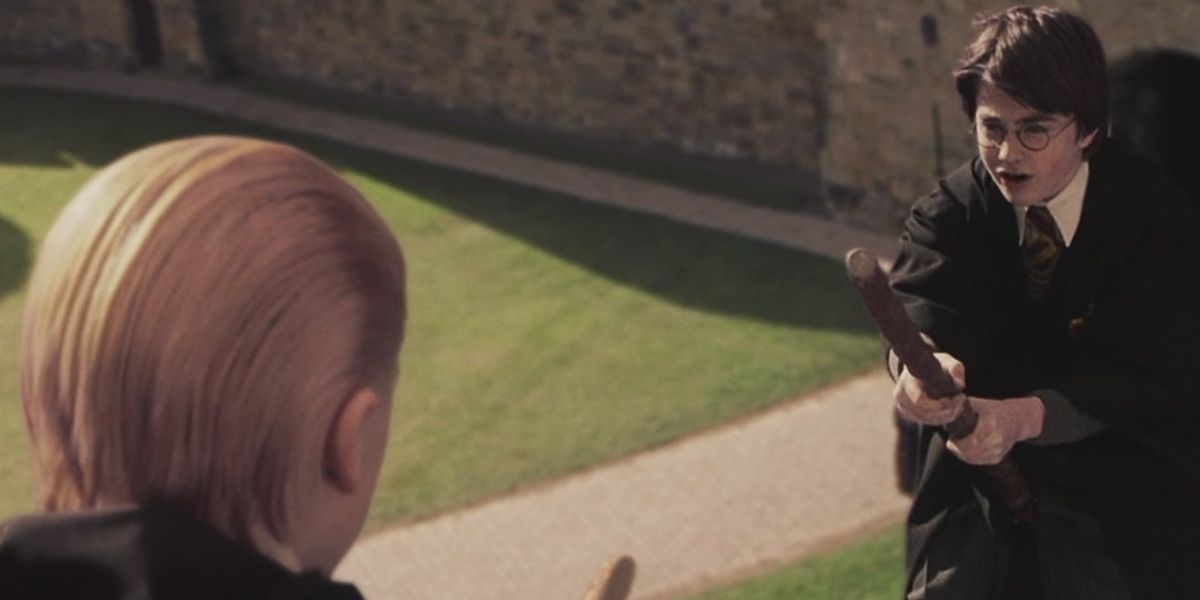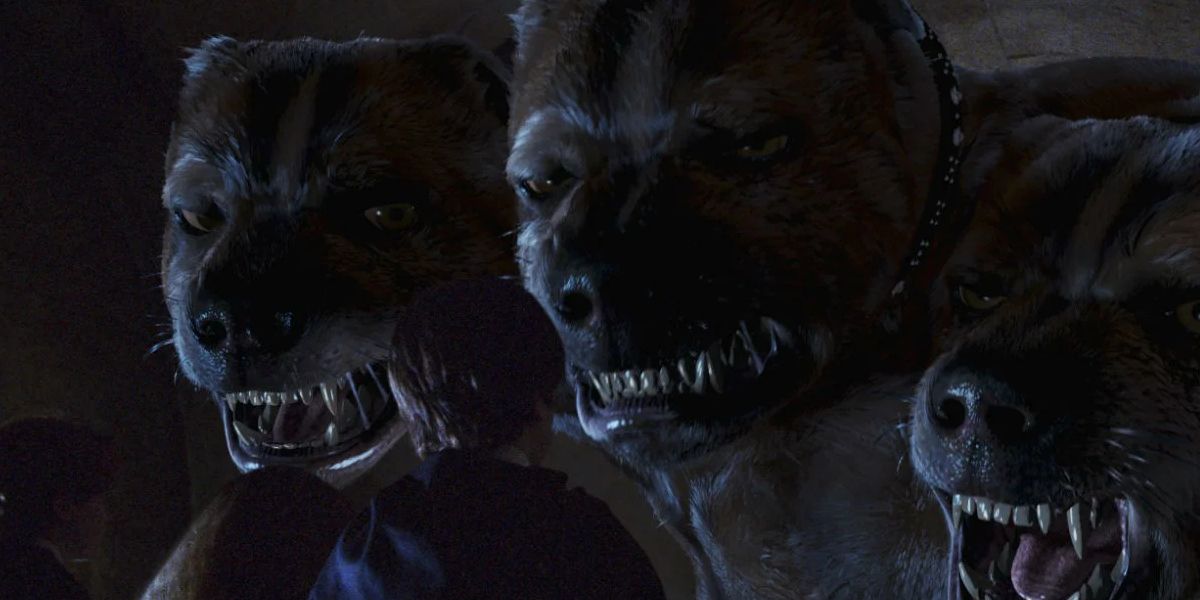Gryffindor, Hufflepuff, Ravenclaw and Slytherin, the four Hogwarts Houses found in the Harry Potter books and movies, are each defined by a set of unique traits that bring like-minded students, and fans, together. The best Gryffindor versus Slytherin dynamic is when it is a showdown between cunning and bravery. However, the best showdown between these traits occurs in the books but not the films.
Harry Potter and the Sorcerer's Stone Chapter Nine "The Midnight Duel" was mostly intact in the film adaption--all the important plot points, at least. What was missing was the setup. The film adaptation had Harry, Ron and Hermione flee from Filch on the restricted third-floor corridor and find Fluffy the Three-Headed Dog because they got lost, which is much different than the setup in the book. In the book, the chapter is about Harry and Ron sneaking out of their dormitory after hours to meet up with Draco Malfoy in the trophy room for a duel. Hermione tries to stop the boys and gets locked out along with Neville Longbottom, who recently returned from the hospital wing, and the four Gryffindors wander the castle at night.
Malfoy challenged Harry to a duel at midnight in the trophy room after their first flying lesson. When Harry and his friends arrive at the trophy room, Malfoy is not there, but Filch and Mrs. Norris are sniffing around for students out of bed after hours. They make their escape, and Hermione rightly explains that Malfoy set them up to get in trouble. Malfoy setting a trap for his enemy is a classic Slytherin move. He relied on his cunning to come out victorious. He also knew the Gryffindors and their inclination towards bravery and chivalry would likely take his bait unquestioningly. It never crossed either Harry nor Ron's mind to not show up for a fight.
It's too bad this little Slytherin versus Gryffindor face-off, or any scene like it, did not take place in the movies. The scene shows how layered the traits of the houses actually are. It is more complicated than good versus evil when it comes to Hogwarts Houses than the movies really dove into. Harry is a picture-perfect image of a Gryffindor. He is brave, loyal and has nerve to spare. Malfoy is an exemplary Slytherin but not only in the stereotypical ways the movies portrayed the house. He has real cunning, and ambition. Those two traits are not inherently evil. Though especially in the later books, Malfoy does use these traits for evil deeds, in the first book, he is just a kid, and he relies on these traits to match up against Harry who does the same in return. Being the exemplary members of their houses such as they are, when their traits let them down, lead them astray or help them secure a victory, it helps to round out the personality of the house in a more complicated and rich way.
If the duel actually happened, and Harry beat Malfoy on nerve alone, Harry would have felt vindicated in his actions. He was, in his mind, standing up to a bully. But in reality, he was breaking the rules after he was just granted special treatment for breaking the rules just a few hours earlier. Hermione is totally right to call him and his actions out as wrong and detrimental to his classmates. Harry's emphasis on his nerve and bravery makes him an obvious Gryffindor, even in situations where he is in the wrong and can not see it. It adds a depth to the Gryffindor house that was lacking in the films.
Harry and his friends escape Filch, Mrs. Norris and Fluffy to awake the next morning to gloat in front of Malfoy in the Great Hall. Harry and Ron take the fact that they did not get expelled or ripped to pieces by a massive three-headed dog as a victory. Only two Gryffindors would consider this a total win. Malfoy still made them look foolish and put them in a very high-risk situation. At best, the incident comes out in a draw.
The reason Harry and Ron think they beat Malfoy is that they believe their nerve in breaking the rules, and their chivalrous commitment to an agreement makes them the better people, the victor. The reason Malfoy earns at least a tie for this round of shenanigans is because he relied on his cunning and manipulation of the system while himself being completely innocent of any repercussions. He did not break any school rules by wandering out a bed after hours. While his plan did not exactly play out the way he wanted, he certainly did not lose anything in the process. His reliance on his personal cunning and surrounding himself with brawnier friends pays off for him at various points in the series, both for worse and for the better.
By cutting a simple scene like this out of the films, the movies missed out on the opportunity to better round out the qualities of the two houses most featured in the series. While, of course, some parts of the book would be inevitably cut from the theatrical adaptation, it is just too bad that the characterization of the house traits was lost. This standoff in the book shows the unique Gryffindor and Slytherin dynamic and how they play off of each other in a way that was never shown in the films.



